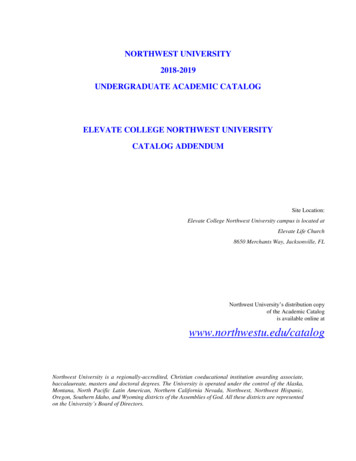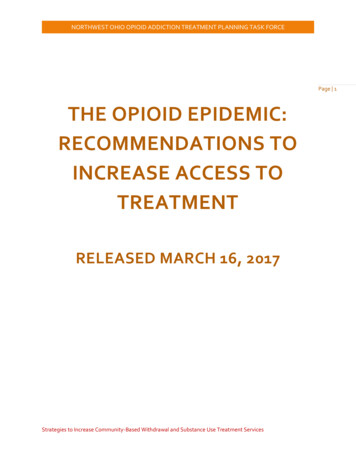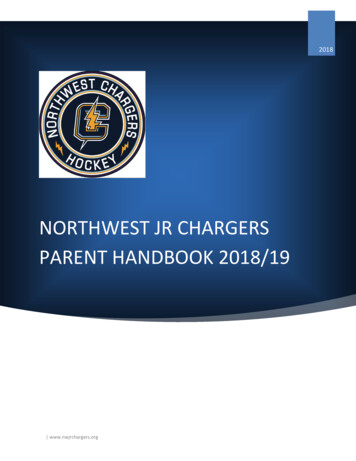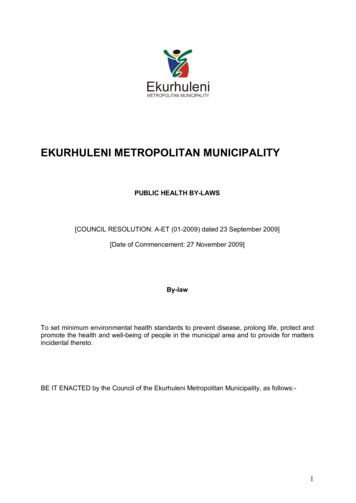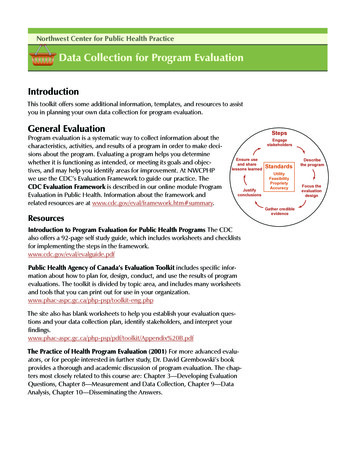
Transcription
Northwest Center for Public Health PracticeData Collection for Program EvaluationIntroductionThis toolkit offers some additional information, templates, and resources to assistyou in planning your own data collection for program evaluation.General EvaluationProgram evaluation is a systematic way to collect information about thecharacteristics, activities, and results of a program in order to make decisions about the program. Evaluating a program helps you determinewhether it is functioning as intended, or meeting its goals and objectives, and may help you identify areas for improvement. At NWCPHPwe use the CDC’s Evaluation Framework to guide our practice. TheCDC Evaluation Framework is described in our online module ProgramEvaluation in Public Health. Information about the framework andrelated resources are at stakeholdersEnsure useand sharelessons learnedJustifyconclusionsResourcesIntroduction to Program Evaluation for Public Health Programs The CDCalso offers a 92-page self study guide, which includes worksheets and checklistsfor implementing the steps in the framework.www.cdc.gov/eval/evalguide.pdfPublic Health Agency of Canada’s Evaluation Toolkit includes specific information about how to plan for, design, conduct, and use the results of programevaluations. The toolkit is divided by topic area, and includes many worksheetsand tools that you can print out for use in your ng.phpThe site also has blank worksheets to help you establish your evaluation questions and your data collection plan, identify stakeholders, and interpret it/Appendix%20B.pdfThe Practice of Health Program Evaluation (2001) For more advanced evaluators, or for people interested in further study, Dr. David Grembowski’s bookprovides a thorough and academic discussion of program evaluation. The chapters most closely related to this course are: Chapter 3—Developing EvaluationQuestions, Chapter 8—Measurement and Data Collection, Chapter 9—DataAnalysis, Chapter 10—Disseminating the cyGather credibleevidenceDescribethe programFocus theevaluationdesign
2Data Collection for Program EvaluationExampleEvaluation PlanProgram:Date:EvaluationQuestionIndicatorsData Source/MethodPerson ResponsibleWord version of sample templateOverview of Data CollectionThis course focuses on step 4 of the CDC Framework: Gather Credible Evidence.There are many different methods for gathering data. You should select themethod that best suits your needs.ResourcesKellogg Foundation’s Evaluation Handbook describes data collection methodsin more detail than this course was able to f (see pages 69–96)The Power of Proof: An Evaluation Primer provides information about preparing to collect data, the different methods for collecting data, as well as tips forbest practice. While this resource is designed for evaluating tobacco preventionand cessation programs, it is applicable to other areas of public health ower-of-proof/data collInstitutional Review BoardsWhen you design your program evaluation, it is important to consider whetheryou need to contact an Institutional Review Board (IRB). IRBs are found at mostuniversities and other large organizations that receive federal funding (suchas hospitals, research institutes, and public health departments). An IRB is acommittee of people who review proposed projects to ensure that the principlesof autonomy, beneficence, and justice are honored.Timeline
3Data Collection for Program EvaluationIt is a fine line between evaluation and research, so it is important that youconsider human subject protections every time your evaluation involves observations of people, interviews, surveys, or the collection of people’s personalhealth information. The Washington State Department of Health developedthe decision tree below to illustrate the difference between research and nonresearch. In general consult an IRB if Your evaluation involves getting information from or about people Your institution or any of your collaborators receive federal funds You hope that the findings of your evaluation can inform other programsIs It Research or Public Health Practice?What is the primary intent?If the project involves humansubjects, is intended to generateor contribute to generalizableknowledge to improve public healthpractice, and the benefits extend tosociety, then the project is research.Contact your agency’s designatedIRB and describe the proposedproject in detail.If the project is intended to prevent a disease or injury andimprove health (or to improve a current, on-going public healthprogram or service) and it benefits primarily the participants,it may be non-research.The project is anevaluation of a new, modified,or previously untested intervention, service, or program.The project involves datacollection/use for the purpose ofassessing community health statusor evaluating an established program’ssuccess in achieving its objectives ina specific population.Does the project involve vulnerable populations or collect sensitive/personal information?Unless IRB staff determine theproject meets criteria forexemption, IRB reviewwill be required.If yes, informalconsultationwith WSIRB isrecommended.360.902.8075.If no, completethe Questions toConsiderWhen UsingHumanParticipants inPublic HealthAssessment &Evaluation andfollow yourdepartment’sprotocols.
Data Collection for Program EvaluationThey will help you determine whether you are doing research, whether yourresearch actually involves human subjects, and whether your research may beexempt from human subjects regulations due to lack of risk to participants.ResourcesWashington State Department of Health Human Subjects uide.htmUniversity of Washington Human Subjects W Human Subjects Division FAQwww.washington.edu/research/hsd/faq.phpThe Belmont Report discusses U.S. law related to ethical treatment of tml4
5Data Collection for Program EvaluationData Collection MethodsMethodUse whenAdvantagesDisadvantagesDocument ReviewProgram documents orliterature are available andcan provide insight into theprogram or the evaluation Data already exist Does not interrupt theprogram Little or no burden onothers Can provide historical orcomparison data Introduces little bias Time consuming Data limited to what existsand is available Data may be incomplete Requires clearly definingthe data you’re seekingObservationYou want to learn how theprogram actually operates—itsprocesses and activities Allows you to learnabout the program as it isoccurring Time consuming Having an observer canalter events Can reveal unanticipatedinformation of value Flexible in the course ofcollecting data Difficult to observe multipleprocesses simultaneously Can be difficult to interpretobserved behaviorsSurveyYou want information directlyfrom a defined group ofpeople to get a general ideaof a situation, to generalizeabout a population, or to geta total count of a particularcharacteristic Many standardized instruments available Can be anonymous Allows a large sample Standardized responseseasy to analyze Able to obtain a largeamount of data quickly Relatively low cost Convenient for respondents Sample may not berepresentative May have low return rate Wording can bias responses Closed-ended or briefresponses may not providethe “whole story” Not suited for all people—e.g., those with low readinglevelInterviewYou want to understandimpressions and experiencesin more detail and be able toexpand or clarify responses Often better response ratethan surveys Allows flexibility inquestions/probes Allows more in-depth information to be gathered Time consuming Requires skilled interviewer Less anonymity forrespondent Qualitative data more difficult to analyzeFocus GroupYou want to collect in-depthinformation from a group ofpeople about their experiences and perceptions relatedto a specific issue. Collect multiple peoples’input in one session Allows in-depth discussion Group interaction canproduce greater insight Can be conducted in shorttime frame Can be relatively inexpensive compared to interviews Requires skilled facilitator Limited number of questions can be asked Group setting may inhibitor influence opinions Data can be difficult toanalyze Not appropriate for alltopics or populations
Data Collection for Program EvaluationDocument ReviewWhen evaluating a program it is helpful to review existing documents to gatherinformation. You can review meeting minutes, sign in sheets, quarterly or annualreports, or surveillance data to learn more about the activities of the programand its reach. You can also review related scientific literature or Web sites tolearn how other similar programs work or what they accomplished. This canhelp inform your evaluation design.ResourcesCDC Evaluation Brief has more information about using existing documents tocollect data for program /brief18.pdfExamplePractical Evaluation: Beginning with the EndSession III: Giving Data MeaningType and source of data for possible use in practical evaluation or communityhealth assessment Birth certificates Death records Disease incidence and prevalencerates Divorce rates Education levels of population(number and percentage of adultscompleting highschool, dropoutrates) Environmental health issues (waterand air quality) English as a Second Language Health services available incommunity, proximity to hospitals,social services, etc. Barriers to accessing services (transportation, hours, language) Hospital discharge data Past decision-making in thecommunity Indicators of cultural communities (community centers, theaters,museums, festivals, dance, ethnicheritage centers or celebrations,cultural organizations, houses ofworship) Indicators of social health (e.g.,substance abuse, crime, childabuse cases) Leading causes of death with age,race, and gender specific datawhere possible Leading causes of morbidity withage, race, and gender specific datawhere possible License data Literacy rates Locally owned businesses Mean family size Median family income by race6
Data Collection for Program Evaluation Percent of community who areMedicaid eligible Percentage of households who rentor own their homes Persons below the poverty level(number and percentage) by race Poison control center data Population distributed by age, race,and gender Registry data Single heads of household (numberand percentage) Surveillance data Transportation issues related tohealthcare (indicator miles ofpublic transit per capita) Un/employment rates by race Vacant land Property assessmentsSourcesMinkler, M. (Ed.), (1997). Community Organizing & Community Building for Health. NewBrunswick, NJ: Rutgers University Press.Quinn, S., (1997). Unpublished syllabus. Chapel Hill, NC: University of North Carolina.ObservationObservation gathers information about a program as the program’s activitiesoccur. Examples could be observing services being provided, training sessions,meetings, or special events. Observation done in an unobtrusive manner canprovide important information about what really takes place.ResourcesCollecting Evaluation Data: Direct Observation The University of WisconsinExtension published a number of brief summaries about program evaluationand methods for evaluation. This segment has sample observation checklisttemplates, a list of aspects of programs that can be systematically observed, andsample field notes.learningstore.uwex.edu/pdf/G3658-5.pdfThe Power of Proof also offers a relatively brief overview of how, when, andwhy you might use observation for evaluation.www.ttac.org/power-of-proof/data coll/observationExampleAs we discussed in the course, it’s important to decide what you need toobserve before you collect data by observation. It is helpful to make a checklistof things you need to look for during the observation period. This is the observation checklist that Anita developed to assess the Brief Preparedness Assessmentand Intervention.7
8Data Collection for Program EvaluationBPAI ObservationChecklistPatient visit 1( done)Patient visit 2( done)Patient visit 3( done)Patient visit 4( done)Patient visit 5( done)Awareness Planning Actions taken Emergency/disasters Local/countyresponse Personal planning Supplies/equipment Preparedness Planbooklet What to Do booklet High Medium Low AssessmentIntervention (key points)Written materials providedPublic Info ProgramcardEmergency phonenumber cardPatient interest levelTotal timeNotesWord version of checklist
Data Collection for Program EvaluationSurveysSurveys allow data to be collected from a large group of people and, dependingupon how the survey is administered, can allow people to remain anonymous.Survey instruments or questionnaires ask questions in a standardized format thatallows consistency and the ability to aggregate responses. Potential questions canfocus on the collection of qualitative or quantitative data.ResourcesSocial Research Methods is a useful site for learning about surveys, interviews,and focus groups.www.socialresearchmethods.netThe Survey Research section is most relevant to surveys, interviews, and y.phpCollecting Evaluation Data: Surveys explores reason to use surveys, alternative to surveys, survey methods (e.g., self-administered, mail, telephone,Web-based), advantages and disadvantages of each, and survey planning andimplementation. It also includes a sample cover letter, follow-up post card, andpress stionnaire Design—Asking Questions with a Purpose covers the prosand cons of questionnaire use, example questions, a comprehensive formattingguide, and a reference list.learningstore.uwex.edu/pdf/G3658-2.pdfWrite more effective survey questionsPamela Narins, Manager, Market ResearchRyerson University, TorontoTips and rules to help you improve your survey question writingNaturally, no question is “good” in all situations, but there are some generalrules to follow. Using these rules and examples will help you write usefulquestions.1. Remember your survey’s purposeAll other rules and guidelines are based on this one. There was a reason youdecided to spend your time and money to do your survey, and you shouldensure that every question you ask supports that reason. If you start to get lostwhile writing your questions, refer back to this rule.2. If in doubt, throw it outThis is another way of stating the first rule, but it is important enough torepeat. A question should never be included in a survey because you can’tthink of a good reason to discard it. If you cannot come up with a concreteresearch benefit that will result from the question, don’t use it.9
Data Collection for Program Evaluation3. Keep your questions simpleCompound sentences force respondents to keep a lot of information in theirheads, and are likely to produce unpredictable results. Example: “Imaginea situation where the production supervisor is away from the line, a seriesof defective parts is being manufactured, and you just heard that a newclient requires ten thousand of these parts in order to make their productionschedule. How empowered do you feel by your organization to stop the lineand make the repairs to the manufacturing equipment?” This question is toocomplex for a clear, usable answer. Try breaking it down into componentparts.4. Stay focused—avoid vague issuesIf you ask “When did you last see a movie?” you might get answers that referto the last time your respondent rented a video, when you are really interested in the last time the respondent went out to a movie theater. Considertoo, “Please rate your satisfaction with the service you have received fromthis company.” This is a fine general question, but will not likely lead toany specific action steps. Particular elements of service must be probed ifresponses are to result in specific recommendations.5. If a question can be misinterpreted, it will be“What time do you normally eat dinner?” will be answered differently bypeople living in different regions; “dinner” can refer to either the midday orthe evening meal. Be clear, concise, always beware of imprecise languageand avoid double negatives.6. Include only one topic per question (avoid “double-barreled” questions)How would you interpret the responses to “Please rate your satisfaction withthe amount and kind of care you received while in the hospital.” or, a question asking about speed and accuracy? If you want to be able to come upwith specific recommended actions, you need specific questions.7. Avoid leading questionsIt is easy, and incorrect, to write a question that the respondent believes hasa “right” answer. “Most doctors believe that exercise is good for you. Do youagree?” is an example of a leading question. Even the most well-meaningresearcher can slant results by including extraneous information in a question.Leading questions can be used to prejudice results.8. Consider alternate ways to ask sensitive questionsSome questions are obviously sensitive. Income, drug or alcohol consumption and sexual habits are clear examples of topics that must be asked aboutcarefully. The question: “Did you vote in the last election?” has an elementof sensitivity in it as well. Respondents might be unwilling to admit that theydid not vote, because of civic pride or embarrassment. To avoid respondentalienation, it can be useful to mitigate the cost of answering “No” by including a way out. For example: “There are many reasons why people don’t get achance to vote. Sometimes they have an emergency, or are ill, or simply can’tget to the polls. Thinking about the last election, do you happen to remember10
Data Collection for Program Evaluationif you voted?” Also, people are less likely to lie about their age in face-to-faceinterviews if they are asked what year they were born, rather than how oldthey are.9. Make sure the respondent has enough informationAsking respondents “How effective has this company’s new distributionprogram been?” may not be as effective as “Recently, we implemented a new,centralized distribution system. Did you know this?” Followed by “Have youseen any positive benefits resulting from this change?” It can be beneficial tobreak down questions that require background information into two parts: ascreening item describing the situation which asks if the respondent knowsabout it, and a follow-up question addressing attitudes the respondent hasabout the topic.Five rules for obtaining usable answersUseful answers are just as important as good questions. Here are some rules:1. Response options need to be mutually exclusive and exhaustiveThis is the most important rule to follow when providing response options. Ifresponse options are not mutually exclusive, the respondent will have morethan one legitimate place for their answer. The response choices, “1 to 2,” “2to 3” and “More than 3” pose a problem for someone whose answer is “2.”You must also ensure that the response options you provide cover everypossibility. Asking “Which of the following beverages did you drink at leastonce during the past seven days?” and providing a list of coffee, soda and teamight be sufficient if you were doing a study on the consumption of caffeinated drinks. But, they would not work if you wanted to know about broaderconsumption habits. If you are unable to provide a complete list of options,at least provide an “Other” choice. If the list of choices is too long, an openended-question might be a better option.2. Keep open-ended questions to a minimumWhile open-ended (or verbatim) questions are a valuable tool, they shouldnot be over-used. Not only can they result in respondent fatigue, but theypose problems in terms of coding and analysis.3. People interpret things differently, particularly when it comes to timeTrouble-spots include responses such as “Always,” “Sometimes” and “Never.”You must build in a temporal frame of reference to ensure that all respondents are answering in the same way. As in this example from an intervieweradministered questionnaire, “I am going to read a list of publications. Foreach one, please tell me whether you read it regularly. By regularly I mean, atleast three out of every four issues.”4. Consider a “Don’t Know” responseIt is useful to allow people to say they simply do not have an opinion about atopic. However, some investigators worry that people will opt for that choice,reducing the ability to analyze responses. Evidence shows that this fear is11
Data Collection for Program Evaluationlargely unfounded. The goal of your research should help you decide if a“Don’t Know” option would be wise. For example, if you only want information from those with an informed opinion or higher interest, offer a “Don’tKnow” choice.5. Provide a meaningful scaleThe end points of response scales must be anchored with meaningful labels.For example, “Please rate your satisfaction with customer service. Let’s usea scale where 1 means ‘Very Satisfied’ and 5 means ‘Very Dissatisfied.’” Youcould also give each point on the scale a label. The number of scale points(3, 5 or 7) can have little effect on the conclusions you draw later. Choosinghow many points, then, is often a matter of taste. There are three things toremember when constructing a response scale. First, an odd number of pointsprovides a middle alternative. This is a good way to provide respondents withmoderate opinions a way out (similar to the “Don’t Know,” choice above).Secondly, if measuring extreme opinions is critical, use a scale with a greaternumber of points. Finally, you generally gain nothing by having a scale withmore than 7 points and will probably find that you will collapse larger scaleswhen it comes time to analyze the data.The price of poorly written questionsWell-written questions are critical. Participants must stay interested. If yourrespondents start to feel alienated by threatening, emotional or difficult questions, response rates are likely to go down and response bias will probably go up.Also, respondents can get frustrated if your questions do not provide answerchoices that match their opinions or experiences. The quality of your collecteddata will suffer; your analyses will be less meaningful; and the whole researchprocess may prove useless or harmful. So think carefully about the questionsyou write, look at reputable examples of questions, and refer to the rules above.If you follow these guidelines, you’ll do fine.ExamplesQuestionnaire template in Word12
Data Collection for Program EvaluationInterviewsConducting interviews is a method that, like open-ended questions in a questionnaire, allows you to obtain an individual’s response in their own words.Interviews differ from questionnaires in that they elicit more detailed qualitative data and allow you to interact with the person to better understandtheir response. Interviews may be conducted in-person or over the phone.Interviewing is useful when you want more in-depth information about aperson’s attributes, knowledge, attitudes/beliefs, or behaviors.ResourcesKey Informant Interviews by the University of Illinois Extension provides anexcellent resource for learning more about key informant interviews.ppa.aces.uiuc.edu/KeyInform.htmResearch Methods Knowledge Base provides a great introduction trview.phpExamplesInterview Documentation Word templateFocus GroupsLike an interview, a focus group allows you to collect qualitative data. However,unlike interviews, in which data are collected by one-on-one interactions, focusgroups provide data about a particular topic through small group discussions.Focus groups are an excellent method for obtaining opinions about programsand services. They produce information from many people in a short period oftime, so can be an effective method when information is needed quickly.ResourcesPerformance Monitoring and Evaluation Tips is a very simple four-page guideto conducting focus groups.www.usaid.gov/pubs/usaid eval/pdf docs/pnaby233.pdfUsing Focus Groups by the University of Toronto Health Communication Unitis a more thorough review of focus group design and use.www.thcu.ca/resource db/pubs/982989842.pdf13
Data Collection for Program EvaluationSamplingWhen you collect data, you should think about your sample. Who will yourecruit to complete your questionnaire or participate in a focus group? How willyou recruit participants? How many should you recruit? As we discussed in thecourse, some of the answers to these questions depend on the sort of information you need.ResourcesSampling and Sample Size Guide / Logistics Guides by the Public HealthAgency of Canada offers an excellent and brief description of /toolkit/Appendix%20D%201-3.pdfSampling, a 12-page guide by University of Wisconsin Extension, has a table ofrandom numbers and suggested sample sizes needed to detect change.learningstore.uwex.edu/pdf/G3658-03.pdfData AnalysisResourcesAnalyzing Qualitative ng Quantitative Datalearningstore.uwex.edu/pdf/G3658-6.pdfProblems With Using Microsoft Excel for Statistics explains why MicrosoftExcel should not be used for more complex statistical analysis.www.stat.uiowa.edu/ jcryer/JSMTalk2001.pdfOther Helpful ResourcesSMART objectiveswww.marchofdimes.com/files/HI SMART pdf/brief3b.pdfReading ry/fry.html14
Data Collection for Program Evaluation Northwest Center for Public Health Practice Introduction This toolkit offers some additional information, templates, and resources to assist you in planning your own data collection for program evaluation. General Evaluation Program evaluation is a systematic way to collect information about the







